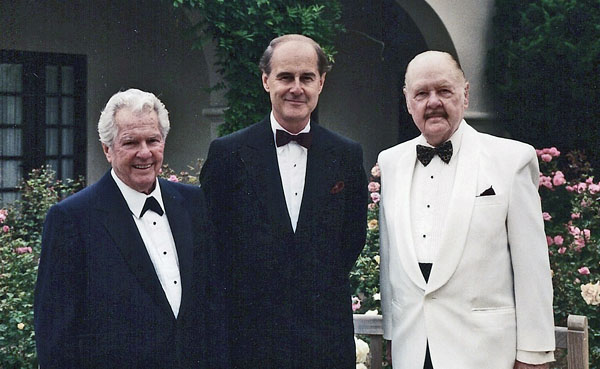
Charles McKimson, Robert McKimson Jr. and Tom McKimson
Robert McKimson is one of the most underappreciated cartoon directors in animation history. Robert McKimson directed some of the most memorable cartoons ever to come out of Warner Bros. McKimson started at Warners in 1931 and eventually became the longest continual employee at Warner Bros. I chatted with his son, Robert McKimson Jr., about his dad and growing up in the McKimson family. He recently wrote a book entitled I Say, I Say… Son!”: A Tribute to Legendary Animators Bob, Chuck, and Tom McKimson. I chatted with him about subjects that didn’t make it into the book.
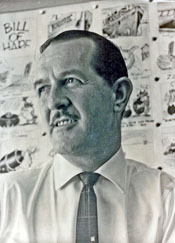
Robert McKimson in 1961
RM: No. I have absolutely no talent. I’m strictly a business person.
KS: Why do you think that your dad isn’t as remembered and revered as the other directors? I always thought it was because he died so young.
RM: That is absolutely correct because he died in 77 at only 66 years old, whereas some directors lived into their late 70s, 80s or 90s. I think that was the main reason.
KS: When did you first realize that your dad was an animator?
RM: I knew he was a cartoonist as long as I could remember. Probably from day one that I could’ve understood. He called himself a cartoonist in those days. I remember going to the movies on Saturdays and see his name. So I understood very early on and was very much aware of what he did for a living.
KS: Did you ever visit the studio?
RM: Many times. I remember visiting both the old studio which they called “Termite Terrace” and the new one over on the Warner lot.
KS: What was it like there?
 RM: The first one was a very old building. When he became a director, he had his office on the second floor. The building was kind of an old wooden building. I remember him showing me around and seeing the inking and painting and coloring and animators. I was there once when they previewed the cartoon to the staff.
RM: The first one was a very old building. When he became a director, he had his office on the second floor. The building was kind of an old wooden building. I remember him showing me around and seeing the inking and painting and coloring and animators. I was there once when they previewed the cartoon to the staff.
KS: What do you think was your dad’s favorite cartoon that he did?
RM: He loved the first Foghorn cartoon he did, Walky Talky Hawky. He really liked Foghorn and that first cartoon. He also liked that offbeat cartoon he did, The Hole Idea. He also enjoyed making the cartoon that he did with Jack Benny, The Mouse that Jack Built. Jack Benny lived not very far from where we did at that time. He enjoyed working with them. Those were some of his favorites. Hillbilly Hare was one of his favorites.
KS: Your dad animated for all of the directors before he became one himself. Who was his favorite to work for?
RM: His favorite directors were Tex Avery and Bob Clampett
KS: I know your dad was an avid polo player. Did he play with the other guys at Warners, and how good at it was he?
RM: He was fair. He played for about ten years from 1932-42 until after the war started. I don’t believe he played with anybody else at the studio. I think his brother Tom played a little bit. I think he played with some Disney people if I recall correctly.
RM: Yeah, he loved bowling, and he did it till the day he died.
KS: Art Leonardi told me that he got into the business thanks to being a replacement bowler for your dad’s team.
RM: Art told me the same story.
KS: I know they did have a studio bowling team for a time. Did he play on that too?
RM: Yes, but he bowled with a masonic team for a number of years. I’m not real sure how long he played with the Warner team.
KS: By the time there were three units, I know every director had to do a number of Daffy, Porky, and of course Bugs.
RM: Yes. They each did 10 cartoons a year. Each one of them had to do so many Bugs and Daffys. Each one of them had their own particular characters. My dads of course were Foghorn Leghorn and the Tasmanian Devil. Chuck of course had the Road Runner and Pepe Le Pew. Friz had Yosemite Sam and Tweety and Sylvester. My father created the original Speedy Gonzales and Friz took over him later.
KS: I know that Tom and Chuck worked for Western Publishing. What made your uncle decide to leave animation and move into comic books?
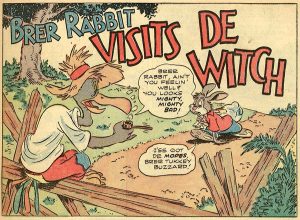 RM: My Uncle Tom left WB in 47 and went to Western to become Art Director for comic and coloring books and also the WB comic strip. Uncle Chuck left WB in 53 and went to Western as Art Director for comic books. When Tom retired, he started doing the comic book artwork, on the side, for Western.
RM: My Uncle Tom left WB in 47 and went to Western to become Art Director for comic and coloring books and also the WB comic strip. Uncle Chuck left WB in 53 and went to Western as Art Director for comic books. When Tom retired, he started doing the comic book artwork, on the side, for Western.
KS: Did Tom work well in switching from animation into print?
RM: Yes, absolutely. He always wanted to work in comic books and coloring books. He did a lot of different comics, including westerns like Gene Autry. In fact, he was friends with Walt Disney because he did the Disney comics.
KS: Your dad worked at Warner Bros from the near beginning till the very end. Did he work on the Bosko pilot too?
RM: He and Tom went there in 31 so he did not work on the pilot. My father was the longest continual director at Warner Bros. It would’ve been Friz but he left for a couple of years. He was the longest continual employee at Warner Bros. He of course stayed till the bitter bitter end in 69.
KS: What was your dad’s opinion of the cartoons that Bill Hendrix produced in the late 60s.
RM: He did not like what was going on at all in the late 60s. He hated it. Warner’s dictated what he could and could not do. The budgets were bad and the characters developed were bad. He did not like them. He wasn’t allowed to use Bugs Bunny. If he was, he would’ve used him and Foghorn Leghorn again. After Daffy’s Diner, Warner’s must’ve said that you can’t use any of the classic characters anymore. That’s when he was stuck with Cool Cat, Merlin the Mouse, and Bunny and Claude. Alex Lovy left so Bill Hendrix got my dad to go back. I think it was clear to my father that the studio was at its bitter end.
KS: Do you think your dad missed the old Warner studio?
RM: Oh yeah. He missed what it was, and he missed full animation. He did not like what was happening to the animation market at all.
KS: What did your dad do for fun besides bowling and polo?
RM: During the 50s, the studio went into this square dancing thing. I also remember Ken Harris, Benny Washam, and Phil Monroe would come over, and they would play poker with my parents.
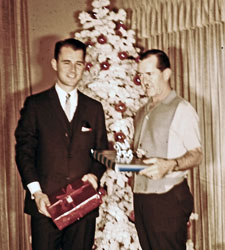
Bob Jr. and Bob Sr. Christmas 1965
RM: One story was that when my father was doing The Mouse that Jack Built. Apparently, they had to do a follow-up recording, and Mary Livingstone refused to go back to the studio, so they had to go up to Jack Benny’s house because apparently, Mary Livingstone was difficult to work with, so they had to go up to their house to finish production.
KS: Do you remember any other projects he enjoyed working on?
RM: I remember him saying he enjoyed working with Jim Backus on A-Lad-In His Lamp. He also enjoyed working on the animation in The Incredible Mr. Limpet. Don Knotts apparently was upset that the animation took twice as long as the making of the actual film.
KS: Do you know anything about any of the other voice actors? I know that Sheldon Leonard did some voice work for your dad.
RM: I’ve got a funny story about that. I went to school with Sheldon Leonard’s daughter, who had a different last name. I never found out who she was until about 20 years ago when at a Beverly Hills high school reunion, she approached me and said: “Oh, my father worked with yours.” I asked who’s your father and she it was Sheldon Leonard and explained to me that Leonard was a stage name.
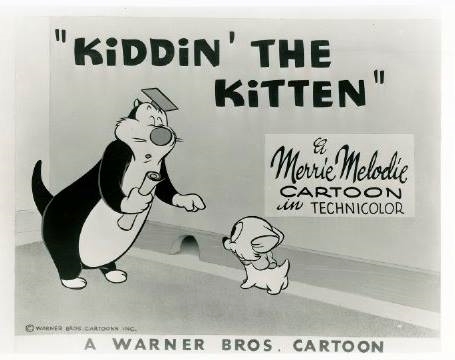


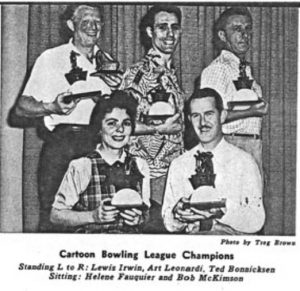
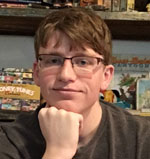 Kamden Spies is an animation fan, collector, and aficionado. He received his undergraduate degree in an IDM in film history and creative writing from the University of Alabama at Birmingham and is currently getting his Master’s in Library and Information Sciences at Indiana University Bloomington.
Kamden Spies is an animation fan, collector, and aficionado. He received his undergraduate degree in an IDM in film history and creative writing from the University of Alabama at Birmingham and is currently getting his Master’s in Library and Information Sciences at Indiana University Bloomington.

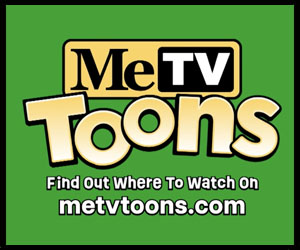
















































I’m sure many of us know that Robert McKimson dropped dead of a heart attack while having lunch with Friz Freleng and David DePatie, immediately after his doctor had given him a clean bill of health. So his life, like many of his cartoons, ended on an ironic twist delivered with impeccable timing.
Those of us who were around then will remember that 1977 was a very big year for celebrity deaths: Elvis, Groucho, Bing, Chaplin, Rochester, Leopold, Zero, Freddie Prinze, Alan Reed…. McKimson’s passing didn’t even make the national news. Even old Burt Mustin got more coverage.
Perhaps one reason McKimson is underappreciated is that he never formed his own production company like Jones, Freleng, Clampett, Lantz, and Hanna and Barbera. When I read Jeff Lenburg’s “The Great Cartoon Directors” over twenty years ago, I was disappointed that not only was there no chapter devoted to him, but his name was only mentioned in passing. Some of his cartoons from the late sixties are pretty dreadful, and I’m not surprised to learn that he disliked them. But I think the best of his work is on a par with that of Jones and Freleng. I’m glad Robert Jr. has written a book about McKimson and his brothers; they deserve more attention.
Lenburg isn’t alone in dismissing McKimson. On “Of Mice and Magic”, Leonard Maltin calls him an “uninspired director”, although he praises individual cartoons like “The Hole Idea” and “The High and the Flighty”.
On a side note, I am interested to know why Warner’s didn’t allow Bugs Bunny on the DePatie-Freleng or Bill Hendricks produced cartoons. One might be tempted to think that they knew most of what they were making was garbage and felt that Bugs was too prestigious a character to work on substandard stuff like that (which begs the question why they felt Daffy or Wile E. weren’t), but the truth is probably more complicated than that.
Tony – Having spoken to Mr. Freleng and Mr. Depatie about it, the order for new cartoons had two agendas. Warners was going to theatrically release the new Road Runners and Daffy/Speedy cartoons alongside a schedule of Bugs Bunny re-releases. It was felt they had plenty of Bugs Bunny shorts. And, secondly, there was feeling at Warners that they needed more Daffy’s, Speedy’s and Road Runners for later syndication (or Saturday morning) play. Teaming Daffy and Speedy was, obviously, a cost-cutting move that gave them the option of putting each of those into either a Daffy or a Speedy show (or package)…
Lenburg dismissed a lot of great directors in his book. He also dismissed Frank Tashlin and every director at Disney.
There’s also the added incentive that Speedy was obscenely popular in the international market, particularly in Spanish-speaking countries, to this day. As bad as those cartoons are, it makes business sense why they were made. Not to disparage Bob McKimson, as Mrs. McKimson passed in 1962 (I believe), and colleagues have told me he was never the same afterwards. But the later work should never undo the earlier work, when Bob McKimson was easily the best studio animator that wasn’t Disney’s (and a pretty fine director, too).
I used to think the same about McKimson not forming his own studio. But McKimson Jr. mentions in the book that Sr. was grieving the loss of his wife in 1963 as to how he lost interest in his work from that point on. That along with the newfound knowledge that Sr. was dissatisfied with the WB output thru the 1960s, which is self evident thru the poor story choices and abandonment of the studio’s characters means that it’s harder to blame shortcomings on McKimson’s directorial skills on McKimson himself.
It should also be noted that Tex Avery never formed his own company, yet is still among the most esteemed of the Termite Terrace directors.
Guy Lombardo and Rochester passed, too. As for McKimsoin, He’s easily the best in my opnion of these. On odd voices, Pat “Ersel” Patrick (“CORN PLASTERED”‘s crow) and PETTICOAT JUNCTION Pat Woodell (Bunny in Bunny and Claude), could also be counted.
Bob went back to a more early 1960s look for the secondary characters in the last scene in his last Warner Bros. cartoon. “Injun Trouble” from 1969 (they could have been used as secondary characters from “Daffy’s Inn Trouble”, which might have been a hint he wasn’t all that happy working with Alex Lovy’s Hanna-Barbera designs at the end). It wasn’t like it was going to make a difference when W-7 was sold to Kinney National Services and the short subjects were shut down. McKimson probably had more fun at the end doing the Plymouth Road Runner commercials or the new bridging segments for “The Bugs Bunny-Road Runner Hour”, where the studio let Bob and his animators work at least briefly with the original characters.
“Rabbit Stew and Rabbits Too!” also harks back to earlier years, as Bob works in expressions, gags and poses from the 1950s through to 1966 (Road Runner Show bumpers). A lot of his W-7 cartoons look like Alex Lovy could have directed them, but not this one.
In an interview with Mark Nardone, McKimson even shrugged off the Pink Panther cartoons he worked on – ‘It’s a cut above, but it’s still limited animation. I’m really not creating anything.” His greatest joy might have been working on Daffy Duck and Foghorn Leghorn segments for Pat Paulsen’s Half A Comedy Hour (January 1970). At least he got a rare chance to have Daffy bounce around and go “Hoo-hoo!”
One of the hallmarks of McKimson’s style is the way his characters are always moving their hands as they talk: gesturing, pointing, slamming a fist into an open palm, and so on. His cartoons also tend to be quite wordy (especially compared to those of Jones, who made so many in pantomime), so this constant gesticulating is very noticeable. Considering how hard it is to draw hands, he really went to a lot of extra trouble; but these detailed and wonderfully executed hand movements really give emphasis to the dialogue and perfectly complement Mel Blanc’s voice work. Yet McKimson was equally adept at animating mute characters, for example the dwarf moose in “The Oily American”.
McKimson’s direction, far from “uninspired”, is truly masterful. Think of the square dance in “Hillbilly Hare”; the long pan shot in “Devil May Hare” showing the Tasmanian Devil’s path of destruction, before we even see the character, and the animal stampede in the same cartoon; the wild climax of “Bushy Hare” where Nature Boy chases Bugs into the kangaroo’s pouch; the electric effects where Bugs kisses the mechanical rabbit in “The Grey Hounded Hare”; and on and on. Then there’s “The Hole Idea”, which McKimson made almost singlehandedly after Warners closed their animation division for half a year and all of his staff had found other jobs. What other director could have done that? No question, McKimson was one of the great ones.
Of the three main animators of the post-48 heyda, I like to think of McKimson as continuing Clampett and Tashlin in a way. His style was the closest to theirs of the three remaining directors (after Davis left), though as Beck points out in the entry for his first film, “Daffy Doodles”, he “settled on a squarer style in the 50’s” (As did everyone else, really!)
the current Boomerang (TV) roatation is playing a lot of his stuff back to back. (Foghorn, Sylvester/Junior/Hippety, Taz and various other Bugs, etc)
The best of McKimson’s Warner Bros. cartoons are as wildly outrageous and funny as the best of those by Clampett and Avery.
My name is Robert William Mckimson. I have seen when I was a kid my name on Saturday morning cartoons as directed by Robert William Mckimson. Does anyone know where the “William” came from?
The cartoonist’s full name was Robert Porter McKimson. I have never seen his middle name or initial on any of his cartoons, let alone “William”.
And also in “The Grey Hounded Hare,” the swish pan from right to left following the electric rabbit as Bugs speed-talks, “Youandmecanmakebeautifulmusictogether!” Brilliant, hilarious.
Bob almost always paired Bugs off against interesting one shot antagonists, from the yokels in Hillbilly Hare to Bruno the circus bear to Pete Puma (it’s a long list). Just one more reason to love his best work.
I’ve read that following a round of layoffs at Warner Brothers, when the people in the Looney Tunes crew came back to work, many, including Robert’s brother, refused to work with Robert. What was that about?
Hard to watch Jones’s Bugs after the way Bob showcased our N.Y. tough-edged rabbit. Paul, above, said it all with his examples. Mr. McKimson’s name was always on the Bugs cartoons my buddies and I liked best when we were kids. He just understood that wabbit and his shenanigans and expressions which in turn became our antics and catchphrases. If you took a poll of teachers from that era, they’d probably prove Bob was behind the majority of cartoon-influenced reprimands in their attempted orderly classrooms. At least, in the Detroit area of my youth! That is the ultimate compliment to the best Bugs director.